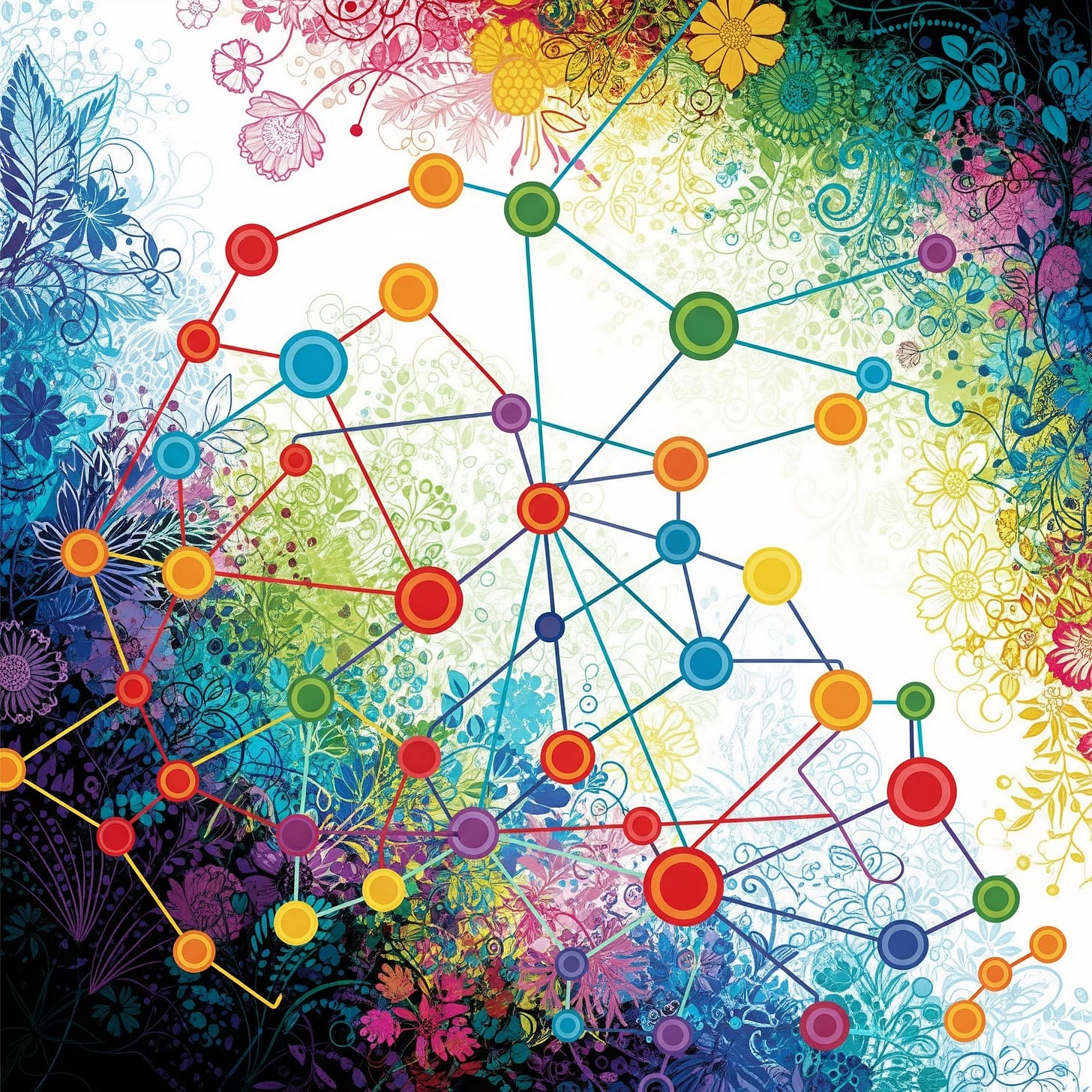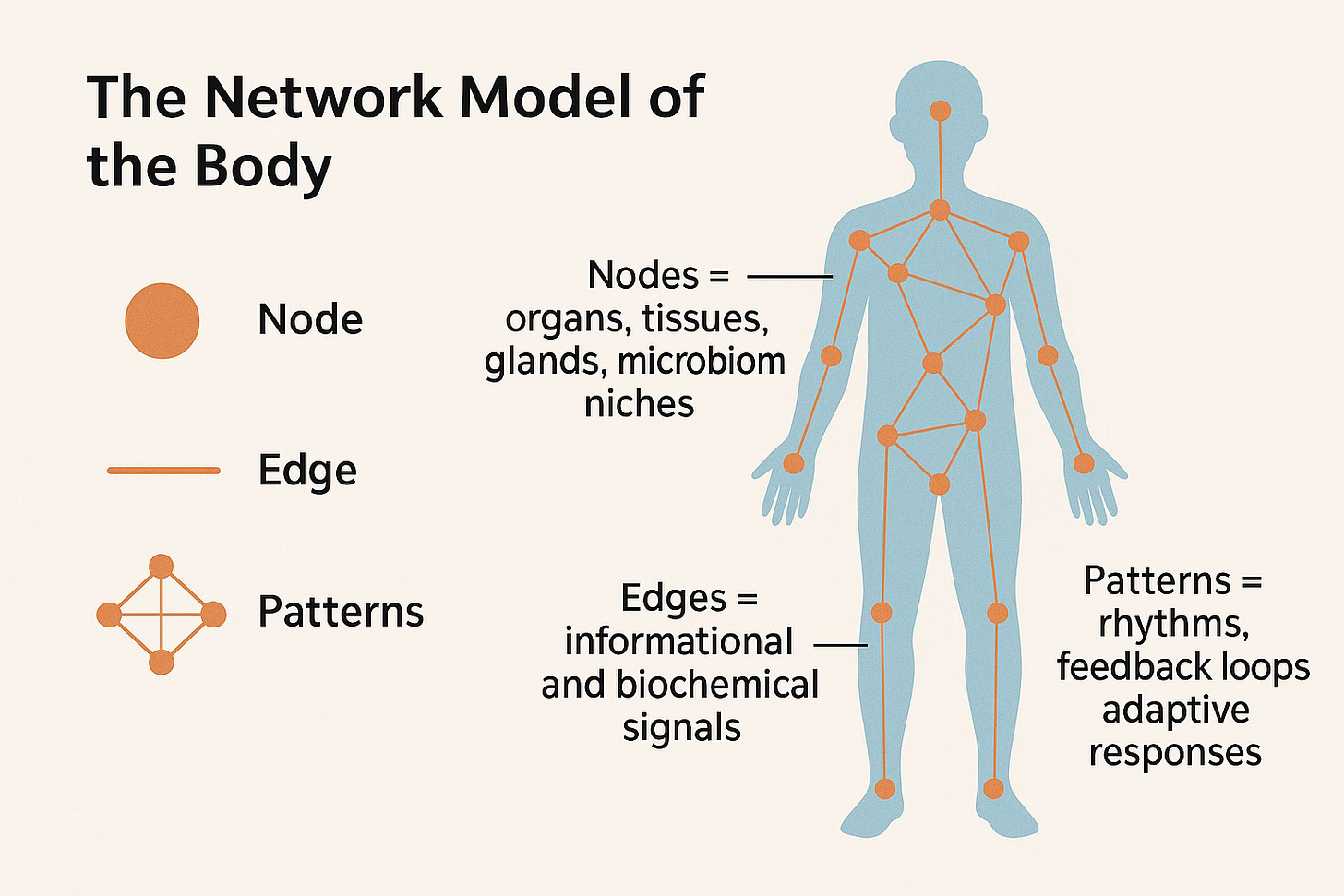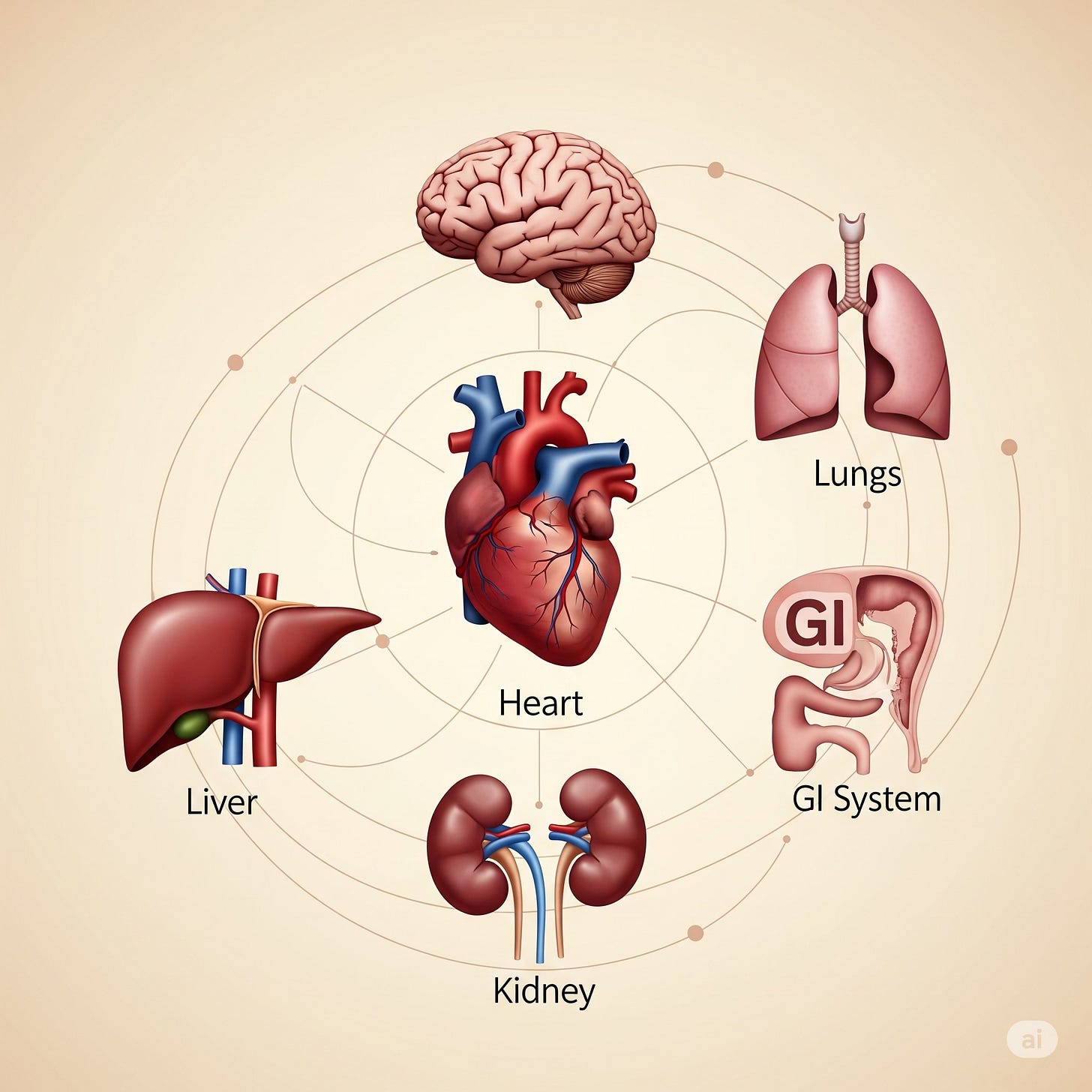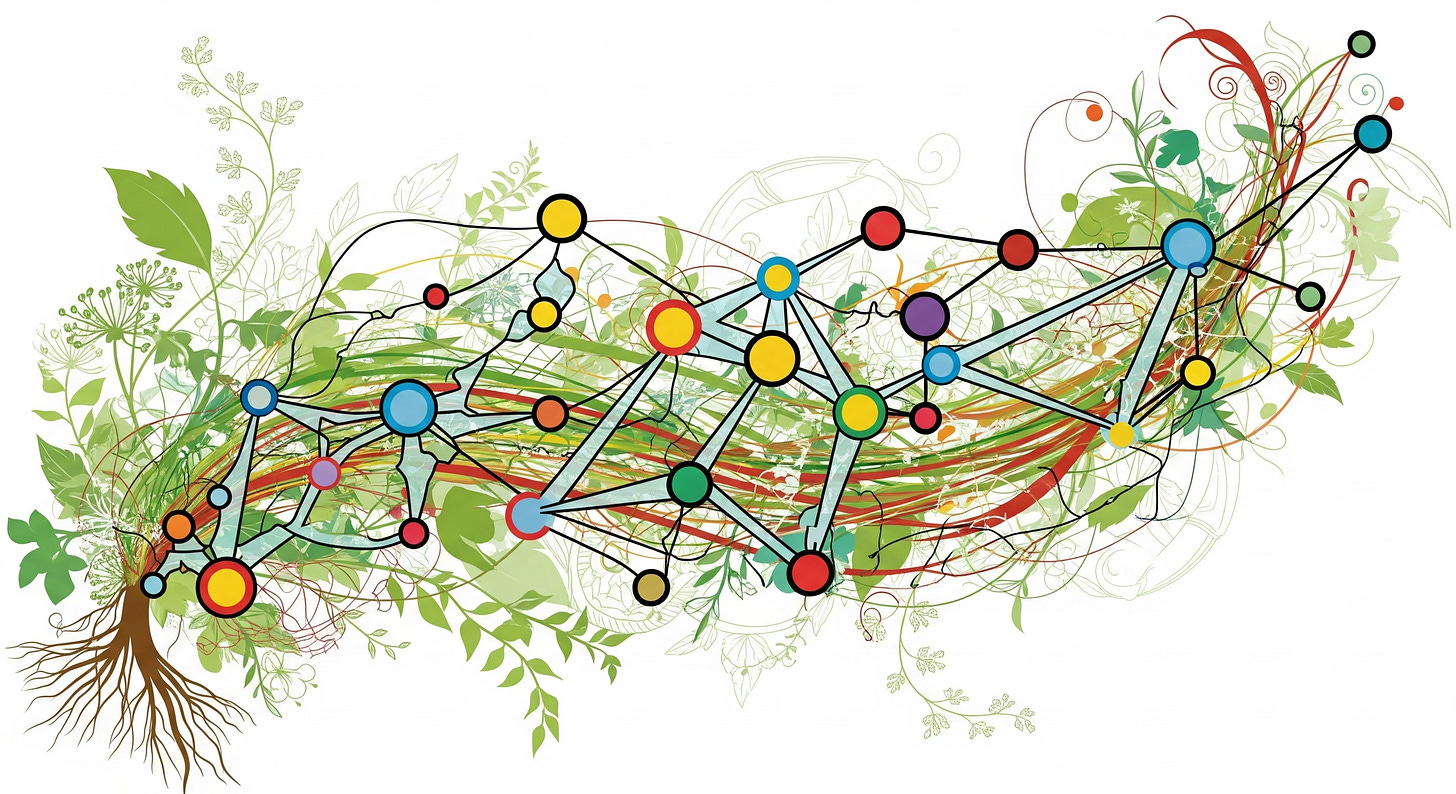Herbs as Signals, Not Substances: Network Physiology and the Intelligence of Healing
How a systems-based view of physiology — and the intelligent use of herbal medicine — can restore coherence, resilience, and vitality.
Introduction
Modern medicine often views the body as a collection of separate parts — a heart, a liver, a brain — each treated in isolation. This framing is no accident; it reflects the metaphors we live by.
As linguist George Lakoff and philosopher Mark Johnson argue, the metaphors embedded in language shape the way we think — often unconsciously (1). In medicine, the dominant metaphors are mechanical and even militaristic: the body is a machine, the doctor a technician or soldier, and disease a malfunction to be fixed or faught (2). Causality is often imagined as a linear chain of events: find the cause, remove the defect, restore the part.
But what if a different metaphor told a better story?
What if we understood the body not as a machine, but as a living network — a dynamic web of interdependent relationships? In this view, organs are nodes, and the signals that pass between them — hormones, cytokines, neurotransmitters, peptides, metabolites, even exosomes — are the edges, the connective pathways. Pull one thread, and the others respond. Disruption in one area doesn't collapse the whole; instead, the system adapts, reroutes, recalibrates.
This is the essence of network physiology — a new framework that moves us beyond reductionism, toward an understanding of health as an emergent property of interconnection (3).
In this model, the physician becomes less a mechanic and more a gardener — or even a musician — cultivating conditions for resilience and restoring harmony. Herbal medicine fits naturally into this paradigm. Rather than forcing fixed outcomes, herbs invite physiological systems back into coherence — restoring rhythm, flexibility, and dynamic stability. They help the body remember how to listen, adapt, and re-integrate its parts into a meaningful whole. In this sense, using herbs is less about fixing broken parts and more akin to retuning an instrument — not imposing order, but restoring the body's innate capacity for self-organization.
From Pathogenesis to Salutogenesis
Conventional medicine is largely guided by a pathogenic model: identify a dysfunctional mechanism (e.g., inflammation), then block or redirect it — for instance, by inhibiting the production or signaling of inflammatory molecules. While this model excels in acute care, it often falls short when addressing chronic conditions or supporting long-term vitality.
In contrast, a salutogenic approach begins with a different question: What creates health? Coined by Israeli-American sociologist Aaron Antonovsky, salutogenesis refers to the mental, emotional, and social processes that enhance the body's ability to adapt, repair, and stay coherent under stress. A central tenet of his work was the concept of the Sense of Coherence--the degree to which individuals perceive life as comprehensible, manageable, and meaningful--which he identified as a key determinant of resilience and well-being (4,5).
Antonovsky did not explicitly address physiology or biology in his model. However, we can meaningfully extend the salutogenic lens to the physiological domain. Just as psychological coherence supports emotional health, physiological coherence — the ability of bodily systems to communicate, regulate, and adapt — is essential to physical health. From this view, agents or interventions that restore homeostasis (stability) and homeodynamics (flexible, adaptive stability) can be considered salutogenic.
Disease, then, is not simply a breakdown in structure or function — it often reflects a loss of adaptive capacity. The healing process is not just about fixing what's broken, but about rebuilding the body's ability to respond intelligently to challenge. This includes not only biochemical pathways, but also the rhythmic, networked communication among cells, tissues, and systems.
To describe this more clearly, we might introduce a new term: salutophysiology — the study and practice of how physiological systems generate, maintain, and restore health through dynamic adaptation, communication, and coherence. Where salutogenesis describes the psychosocial and existential conditions that support well-being, salutophysiology extends that framework into the biological realm: it asks not only what creates health, but how living systems enact and sustain it at the molecular, cellular, and network levels.
Herbal medicine, when practiced in this spirit, is fundamentally salutogenic — and salutophysiological. Herbs do not “treat diseases” in the pharmaceutical sense. Instead, they nourish, signal, and support the restoration of internal order — from the cellular level outward. Many herbs act not by overriding the body, but by nudging it — reawakening latent processes of repair, recalibration, and resilience. In this way, they help restore physiological coherence and rekindle the intelligence of the living system.
If salutophysiology describes how the body maintains coherence through adaptive signaling and inter-system communication, then we need a framework to visualize and analyze those connections. This is where network physiology offers a powerful lens. Instead of viewing organs and systems as isolated compartments, it maps the body as a web of interacting nodes and edges — revealing how health arises not from individual parts, but from the quality of their relationships (6).
Mapping Salutophysiology: The Network View of the Body
To understand the body as a network, we first need to understand what a network is in science.
At its simplest, a network is a system of nodes (points) connected by edges (relationships). Network science is used to study systems ranging from ecosystems and economies to brain activity and social media (7). What makes networks powerful is not just the parts themselves, but how those parts interact, respond, and adapt to one another over time.
When applied to physiology, this way of thinking reveals a radically different map of the body — not as a collection of compartments, but as a living web of relationships.
In this network view:
Nodes = organs, tissues, glands, and even microbiome niches
Edges = informational and biochemical signals that link them — hormones, neurotransmitters, cytokines, metabolites, and more
Patterns = the rhythms, feedback loops, and adaptive responses that sustain health
This model recognizes that health is not static; it emerges from the dynamic interplay among all parts. Each node must be functionally competent, and the connections between them must remain open, accurate, and responsive.
Unlike mechanical systems, the body’s network operates with a form of distributed intelligence — the ability to self-organize, compensate, and repair. A disturbance in one area can ripple through the system, but the network has built-in mechanisms for recalibration.
Importantly, this is not a fixed or rigid network. The edges — the signaling pathways — are often rhythmic, reflecting circadian patterns (like hormonal pulses), ultradian cycles, and even seasonal adaptations. Communication between parts is not just chemical or molecular, but also mechanical (via fascia and tissue tension) and electrical (through fields and voltage gradients) — layers of interconnection that we're only beginning to appreciate (8).
And networks exist at multiple levels:
Cells form tissue networks
Tissues and organs form organ-level networks
The microbiome forms its own adaptive network in dialogue with the host
Even the brain-gut axis or neuroendocrine-immune system can be viewed as higher-order subnetworks within the body
Understanding the body this way helps us move from a view of dysfunction as damage to a view of health as coherence— the capacity of the whole system to communicate, respond, and realign under changing conditions.
Importantly, not all physiological networks are structured the same way. Some, like the liver, function as tightly organized networks — dense, localized, and highly integrated. Others, like the immune system, are distributed networks — with nodes (immune cells and organs) spread throughout the body and communication occurring across vast distances.
In between are what researchers increasingly describe as body axes — structured signaling pathways between specific organ systems, such as the gut-brain axis, heart-kidney axis, or gut-lung axis (9, 10, 11). These axes represent high-traffic edges within the network, where bidirectional communication plays a crucial role in regulating immunity, mood, metabolism, and more. Recognizing these axes as core pathways in the body’s internal dialogue helps refine our understanding of how local imbalances can ripple outward — and how healing one part can influence another.
If health is the emergent property of dynamic signaling within a living network, then any true medicine must act not by overriding that network, but by interacting with it intelligently. This brings us to herbal medicine — not as a form of chemical warfare, but as a language of healing. Herbs, when viewed through the lens of salutophysiology, are not just passive substances. They are biological signals — information-dense inputs that support adaptation, recalibration, and resilience.
Herbs as Signals—Not Just Substances
In this context, herbs are not merely passive sources of chemicals. They are informational agents — complex biochemical messages delivered through phytochemicals (and perhaps subtler, not-yet-understood vectors).
Every herb carries a phytochemical “signature” — a constellation of molecules evolved in response to environmental challenges like heat, drought, pathogens, or predation. These signatures encode specific adaptive strategies. When humans ingest these compounds, they don’t just provoke a reaction; they convey signals that our biological systems can decode and respond to (12).
Some examples:
- Phenols/Flavonoids modulate intracellular signaling pathways and gene expression
- Alkaloids influence neural transmission and hormonal feedback loops
- Triterpenoids regulate immune tone and support membrane integrity
Rather than imposing a fixed outcome, herbs gently invite physiological systems back into coherence — restoring rhythm, resilience, and adaptive flexibility. From this perspective, herbal medicine acts like network tuning, guiding the body to remember how to listen, adapt, and reintegrate its parts into a harmonious whole. Using herbs, then, is less about repairing broken mechanisms and more like retuning a musical instrument to restore its natural harmony.
Node Strengthening and Network Resilience
When a node (say, the liver or the brain) is compromised, its ability to communicate with the wider network falters. Feedback loops get distorted. Inflammation may spread. Adaptability declines.
In a salutophysiological framework, herbs act by strengthening these nodes — restoring cellular signaling, metabolic clarity, and organ-level rhythm. This, in turn, improves how that node participates in the larger physiological network.
- Milk thistle strengthens hepatocytes, supports glutathione recycling, and enhances resistance to oxidative stress (13)
- Ashwagandha restores neuroendocrine balance, dampens maladaptive stress signaling, and modulates immune activity (14)
- Hawthorn improves endothelial function, cardiac tone and rhythm, enhancing autonomic coherence across heart-brain-gut axes (15,16)
These effects ripple outward — restoring communication, resolving dissonance, and reweaving coherence throughout the system.
Beyond Linear Thinking — The Limits of “Treating the Cause”
In natural medicine circles, we often pride ourselves on going deeper than symptom relief — on “treating the root cause.” While this intention is laudable, it can unintentionally trap us in the same linear thinking that underpins conventional pharmacology.
In reality, complex systems don’t have a single cause. Disease rarely arises from just one broken piece. Instead, it emerges when the integrity of the whole network is compromised — when too many weak links accumulate, feedback loops break down, and the system can no longer adapt.
In a network model:
- There is no singular root cause, but rather nodes that become vulnerable or overloaded
- The body often compensates by rerouting signals through alternate nodes or networks
- A weak liver node might strain the gut-brain axis, or poor vagal tone may amplify immune dysregulation — but there’s no single domino
Herbs, when used wisely, don’t seek to eliminate “the cause” — they support the restoration of systemic integrity. They strengthen nodes, improve signaling fidelity, and allow the network to re-establish coherence on its own terms.
So rather than asking “what herb treats this condition?”, we begin to ask:
- Where is the network under strain?
- Which nodes need reinforcement?
- What signals have become distorted or noisy?
This shift in perspective moves us away from mechanistic intervention and toward collaborative restoration — where the goal is not to fix the body, but to support it in reclaiming its inherent intelligence.
Reclaiming Coherence in a Non-Linear World
Herbs don’t fight disease. They support the intelligence of the system.
They do not treat linear “causes” — because in a truly living network, cause and effect are distributed, circular, and emergent. Instead, herbs restore pattern, signal integrity, and nodal strength — which allows the entire system to reorganize toward greater coherence.
This shift — from symptom suppression, past root-cause fixation, and toward network-informed support — offers a more realistic and compassionate framework for healing in a complex world.
Coming Next:
Node Medicine: How Herbs Strengthen Organ Integrity
→ We’ll look at the unique characteristics of node-focused herbal action — how herbs target and restore specific organs, and why this matters for systemic resilience.
Note: Images in this post were generated with the assistance of an AI model.
References
Lakoff G, Johnson M. Metaphors we live by. Chicago: University of Chicago Press; 1981.
Casarett D, Pickard A, Fishman JM, Alexander SC, Arnold RM, Pollak KI, Tulsky JA. Can metaphors and analogies improve communication with seriously ill patients? J Palliat Med. 2010 Mar;13(3):255–60. doi: 10.1089/jpm.2009.0221. PMID: 19922170; PMCID: PMC2883475.
Ivanov PC. The new field of network physiology: Building the human physiolome. Front Netw Physiol. 2021 Jun 30;1:711778. doi: 10.3389/fnetp.2021.711778. PMID: 36925582; PMCID: PMC10013018.
Antonovsky A. The salutogenic model as a theory to guide health promotion. Health Promot Int [Internet]. 1996 Jan 1 [cited 2025 Jul 9];11(1):11–8. Available from: [https://doi.org/10.1093/heapro/11.1.11](https://doi.org/10.1093/heapro/11.1.11)
Mittelmark MB, Bauer GF. The meanings of salutogenesis. In: Mittelmark MB, Sagy S, Eriksson M, Bauer GF, Pelikan JM, Lindström B, Espnes GA, editors. The handbook of salutogenesis [Internet]. Cham (CH): Springer; 2017 [cited 2025 Jul 9]. Chapter 2. Available from: [https://www.ncbi.nlm.nih.gov/books/NBK435854/](https://www.ncbi.nlm.nih.gov/books/NBK435854/) doi: 10.1007/978-3-319-04600-6_2
Bartsch RP, Liu KK, Bashan A, Ivanov PCh. Network physiology: How organ systems dynamically interact. PLoS One. 2015 Nov 10;10(11):e0142143. doi: 10.1371/journal.pone.0142143. PMID: 26555073; PMCID: PMC4640580.
Barabási AL, Pósfai M. Network science. Cambridge: Cambridge University Press; 2016.
Nunn A. We are electric: The New Science of Our Body’s Electrome, by Sally Adee. Bioelectricity [Internet]. 2023 Jun 1;5(2):147–149. Available from: https://doi.org/10.1089/bioe.2023.0016
Carabotti M, Scirocco A, Maselli MA, Severi C. The gut-brain axis: interactions between enteric microbiota, central and enteric nervous systems. Ann Gastroenterol. 2015 Apr-Jun;28(2):203-209. PMID: 25830558; PMCID: PMC4367209.
Abassi Z, Hamo-Giladi DB, Kinaneh S, Heyman SN. The endocrine basis of the cardio-renal axis: New perspectives regarding corin. Physiol Rep. 2024 Jul;12(13):e16105. doi: 10.14814/phy2.16105. PMID: 38942727; PMCID: PMC11213627.
Enaud R, Prevel R, Ciarlo E, Beaufils F, Wieërs G, Guery B, Delhaes L. The Gut-Lung Axis in Health and Respiratory Diseases: A Place for Inter-Organ and Inter-Kingdom Crosstalks. Front Cell Infect Microbiol. 2020 Feb 19;10:9. doi: 10.3389/fcimb.2020.00009. PMID: 32140452; PMCID: PMC7042389.
Brimson JM, Prasanth MI, Malar DS, Sharika R, Sivamaruthi BS, Kesika P, Chaiyasut C, Tencomnao T, Prasansuklab A. Role of herbal teas in regulating cellular homeostasis and autophagy and their implications in regulating overall health. Nutrients. 2021 Jun 23;13(7):2162. doi: 10.3390/nu13072162. PMID: 34201882; PMCID: PMC8308238.
Achufusi TGO, Pellegrini MV, Patel RK. Milk thistle [Updated 2024 Feb 28]. In: StatPearls [Internet]. Treasure Island (FL): StatPearls Publishing; 2025 Jan– [cited 2025 Jul 9]. Available from: [https://www.ncbi.nlm.nih.gov/books/NBK541075/](https://www.ncbi.nlm.nih.gov/books/NBK541075/)
Lopresti AL, Smith SJ, Malvi H, Kodgule R. An investigation into the stress-relieving and pharmacological actions of an ashwagandha (Withania somnifera) extract: A randomized, double-blind, placebo-controlled study. Medicine (Baltimore). 2019 Sep;98(37):e17186. doi: 10.1097/MD.0000000000017186. PMID: 31517876; PMCID: PMC6750292.
Wu M, Liu L, Xing Y, Yang S, Li H, Cao Y. Roles and mechanisms of hawthorn and its extracts on atherosclerosis: A review. Front Pharmacol. 2020 Feb 21;11:118. doi: 10.3389/fphar.2020.00118. PMID: 32153414; PMCID: PMC7047282.
Wyss C, Gündling PW, Kostev K. Real world effectiveness of hawthorn special extract WS 1442 in a retrospective cohort study from Germany. Sci Rep. 2024 Oct 3;14(1):22986. doi: 10.1038/s41598-024-74325-4. PMID: 39362947; PMCID: PMC11450181.








Exciting to continue learning from you all these years later! 😊
Keep them coming!